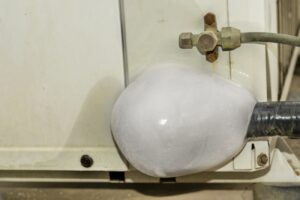
Ice appearing on parts of an air conditioning system, usually along the indoor evaporator coil, is a common HVAC problem, and one that people often misunderstand. To someone unfamiliar with how air conditioning works, seeing ice may simply seem like a sign the AC is working extremely well, making the air so cold that it’s creating ice.
This isn’t what’s happening. Ice should never appear on an air conditioning system, and its presence makes it harder for an AC to do its job. If the air conditioner doesn’t receive repairs, the ice will continue to grow and eventually cause the AC to stop cooling entirely.
Below we’re going to look at why ice might form on your air conditioner and why you need it fixed right away.
Ice appears because the evaporator coil isn’t absorbing enough heat
This is the basic reason for ice forming along parts of the AC, starting with the evaporator coil. This coil contains cold refrigerant, which evaporates as it comes into contact with the warm air the blower fan pushes over the coil’s surface. As the refrigerant evaporates, it absorbs heat from the air, cooling down the air for distribution through the ventilation system and the rooms of the house.
If the evaporator coil, for whatever reason, cannot absorb enough heat, it will leave the refrigerant inside the coil below freezing. The moisture that normally forms along the coil will freeze into ice. Because this ice also blocks heat absorption, the process will continue until the coil is fully frozen over—and the AC won’t provide cooling at all.
Common reasons for the evaporator coil to lose heat absorption
Now we’ll get into the specifics of ice development. The evaporator coil can start to fail to absorb enough heat for several reasons:
- Low airflow: The AC’s blower fan pulls warm air from the house through the return air ducts and sends it over the evaporator coil. If this airflow declines, the coil won’t have enough heat available to warm up the refrigerant. The most frequent cause of low airflow is a clogged air filter, which you can correct by putting in a clean filter. A faulty blower fan can also lead to a drop in airflow.
- Dirt and grime along the coil: A layer of dirt or grime on the coil creates an insulating layer that slows down heat absorption and often leads to coil freeze. Regular maintenance can help prevent this, as well as to remember to regularly change the air filter that stops dirt and dust from getting into the cabinet in the first place.
- Leaking refrigerant: Yes, less refrigerant can lead to ice forming. The problem is that a lower refrigerant charge due to leaks lessens how much heat the evaporator coil can absorb, which leaves the remaining refrigerant at below-freezing. Refrigerant leaks put an AC in serious jeopardy of a system breakdown and need professional repairs ASAP.
Trying to scrape the ice off the coil won’t solve the underlying problem, and it also risks damage to the coil that will make the situation worse. When you have an icing problem with your air conditioning in Parksville, BC, shut the AC off and call our technicians to diagnose and solve the problem.
Temprite Climate Solutions serves Courtenay, BC and the Surrounding Areas. For a job done right, call Temprite!
